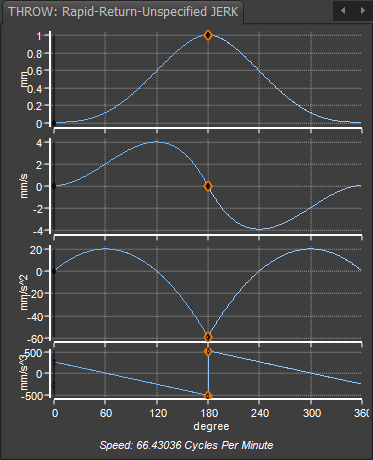Throw: Rapid-Return Finite Jerk
The Throw Motion-Law Unlike other motion-laws, the Throw motion-law rises from its Start-Position to its maximum displacement, and then returns to its Start-Position. To give you maximum flexibility, use two Flexible Polynomial segments to design the Throw motion-law. Usually, the two segments have equal durations, but it is not necessary. Throw: Rapid-Return 1 - Zero Jerk at Start and End. Because you use two Flexible-Polynomial segments to design the Throw motion-law, you can enter different motion-values and motion-constraints at its start, its maximum displacement, and at its end. This Throw has a Quick-Return because it has a LARGE negative acceleration, and unspecified Jerk, at its maximum displacement - the transition from Rise to Return. See also: •Quick Return 1: Finite Jerk @ Start/End/Mid-Point •Quick Return 2: Zero Jerk @ Start/End/Mid-Point •Rapid Return 2: Smooth-Start/End Two Segment 'Rapid-Return Motion 1 |
|
|
Motion-Values of each motion-derivative Start of Rise segment 1 : •Position = 0 •Velocity = 0 •Acceleration = 0 •Jerk = Unspecified ( Actual value = 260.6m/s/s/s ) Middle Blend-Point *: •Position = 1 •Velocity = 0 •Acceleration = Unspecified ( Actual value = -58.84mm/s/s ) •Jerk = Unspecified ( Actual value = ±521.167mm/s/s/s ) End of Return segment 2 : •Position 2 = 0 •Velocity = 0 •Acceleration = 0 •Jerk = Unspecified ( Actual value = -260.6mm/s/s/s ) * Edit the X-axis value of the middle Blend-Point to give an asymmetrical motion. |
